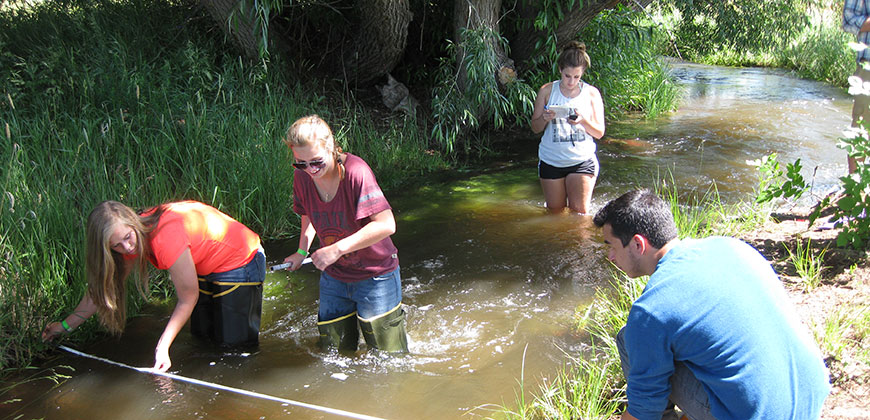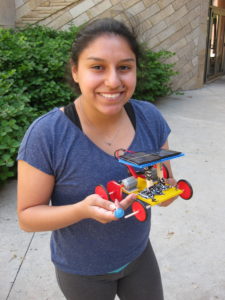
High school students from around the country get hands-on (and feet-wet) science experiences in Colorado at the College of Natural Sciences Education and Outreach Center’s SciTrek camp, happening this week.
They come from Michigan and Virginia, Georgia and Illinois. And this week they are at CSU getting their feet wet (sometimes literally) in real science.
They are the more than one-dozen high school-age participants in the College of Natural Sciences’ SciTrek camp, run by the college’s Education and Outreach Center (EOC). The SciTrek Program for Future Scientists attracts students from around the country (and sometimes around the world) to stay at CSU for five days, spend the nights in the dorms and learn about science in the mornings – and attend the Summer Vet program in the afternoons.
“It’s a chance for them to experience different sciences – and things they may not get in their classrooms back home,” says Courtney Butler, assistant director of the EOC. Like what? A GPS geocaching mystery, in-stream water analysis and a fast-paced solar car challenge, for starters. “The majority of the participants are female,” she says, “so to get them exposed to the natural sciences and engineering is important.”
Real science
The camp proves popular year after year, filling up quickly with students who find it online. “A lot of them are interested in science in general,” says EOC director Andrew Warnock. “But we try to show them cool stuff that takes their science education to the next level.”

For example, campers often delight in the dendrochronology project, in which they learn about environmental changes by studying tree rings. They venture into Lory State Park with a U.S. Forest Service scientist to extract tree cores, before taking the samples back to the lab on campus to analyze them.
Getting out into the field is important, says Warnock. “We don’t want to bring these kids all the way to Colorado and then just sit inside a classroom,” he says. “We want to have them doing real, hands-on science – and to see what it’s like to be a real scientist.”
The activities are not dreamed up out of teaching guides. They are based on science being conducted at the university as part of grants from the National Science Foundation. The center leverages the outreach components of the grants to create educational kits – used by local students and teachers during the school year and put to work in the summer by the SciTrek campers. “They get to study first-hand, as an NSF-sponsored researcher would study it,” Warnock says of the participants.
But substantial thought does go into the planning and teaching, Warnock notes. They work hard to integrate these real-world applications into what students have learned in the classroom. And in addition to the center’s staff, they have a science teacher-in-residence as well as students from the college who are training to be science teachers.
Core lessons
The camp’s reputation spreads far and wide. Last year one student traveled from her hometown of Waltham, Mass. to attend. “It was my first time in Colorado, and I felt so welcomed at the camp,” Noemi Guevara writes in an email. “For whatever topic we were learning about during the day, there was a teacher who knew about it,” she notes. “The teachers were so willing to explain things. It provided us the chance to really learn about the topic and gain an interest.”
In particular, she was captivated by the dendrochronology activity. “I didn’t even know that was a thing,” she writes. “I was super excited to go out and actually do the tree coring myself. That’s an experience I wouldn’t have been able to do everywhere!” In fact, she still has the core sample in her room at home as a reminder. “It amazes me everything you can learn about a tree from the core,” she notes.
She so enjoyed her science experience at CSU that she will be enrolling here as a first-year student in the fall. She plans to study animal science or zoology. “I am very excited to join the Ram family!” she says.
Guevara is just one of the latest to make the move from SciTreker to science undergraduate. The program has now been running for more than 12 years and has converted its share of high school students to the sciences – and to CSU. In fact, at least nine of last year’s SciTreck campers will be returning to campus this fall, now as freshmen.
But most importantly, says Butler, while they’re here, “they have lots of fun.” Guevara agrees: “I was engaged in the camp and constantly having fun.”